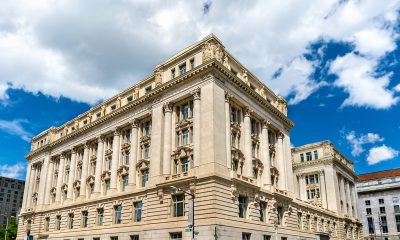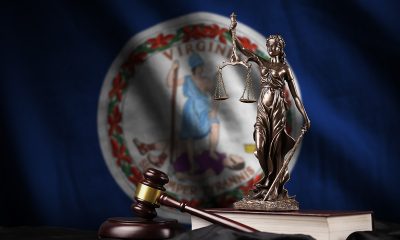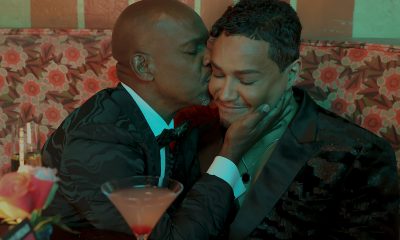a&e features
Letting it all hang out at Pride — did it help us in the long run?
We asked a veteran bike dyke, drag queen, leather daddy and go-go dancer to share their first-hand experiences
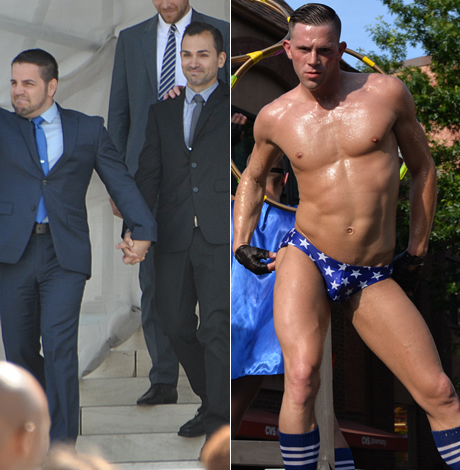
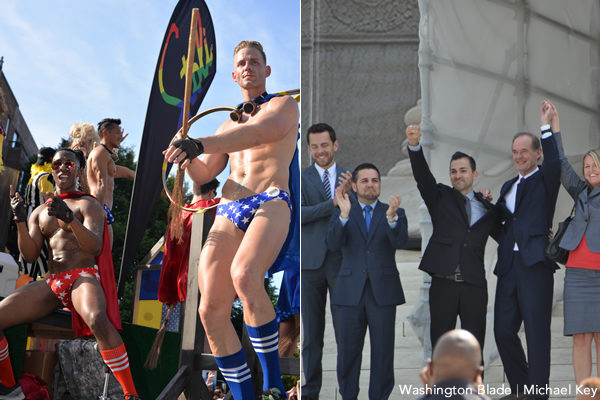
Capital Pride and all Pride events have always been — historically and to this day — a place to let one’s hair down and for LGBT folks to be unabashedly themselves.
Washington, widely seen as a more “buttoned-up” town than, say, New York or Los Angeles, was perhaps not as freewheeling as other cities, especially in the early years of Pride here when it was a one-day block party just off Dupont Circle beginning in 1975, but it’s grown hugely over the decades and for many years we’ve had all the revelers one would expect — scantily clad dancers gyrating around on parade floats, drag queens, leather daddies (sometimes in ass-less chaps), dykes on bikes (some topless) and more.
Conversely, the image the movement presented in the marriage wars and with LGBT people seeking elected office, was much different. Barney Frank and Tammy Baldwin dressed as conservatively as their counterparts on Capitol Hill, there was never anything outré about plaintiffs like Edith Windsor and Jim Obergefell and not-so-surprisingly, current “it” boy wonder, presidential hopeful Pete Buttigieg, is a young, heteronormative-type white gay guy who’s from the Midwest and goes to church.
The dichotomy has always existed as far back as the late Frank Kameny and the late Barbara Gittings demonstrating (pre-Stonewall) at the White House in skirts (for women) and suits (for men) while the gay masses — practically none out pre-’69 — tended to glom on more to the hippies than the Ozzie and Harriets. One of the organizers of the 1993 Gay March on Washington drew criticism from within LGBT circles for wearing leather to the White House to meet Bill Clinton.
But given the mainstream media’s penchant for televising more flamboyant factions in its Pride coverage and political enemies on the right painting Pride gatherings as dens of debauchery, what kind of tension existed between the two extremes? And now 50-some years down the road, did any of it matter? Might we have gotten further faster if we’d somehow reined in our Pride season excesses?
Many folks say either no, it’s a self-hating query or it’s irrelevant.
Or perhaps we needed both?
That’s what Cathy Renna, a long-time PR and media LGBT expert formerly of GLAAD, says.
“We need all of it. Why? Because we are all of it,” Renna says. “Our community is all of it and I think it’s disingenuous to even try to divide people over this. Why are we always trying to divide each other all the time? There are always gonna be folks out there going to Pride because they just want for that one day or one week out of the year, to let their hair down and celebrate, and when I say celebrate, I don’t mean just have a party and get drunk. I mean celebrate our community,
Renna, GLAAD’s national news media director from ’95-’02 and a volunteer for several years prior, says the issue has ramifications in how it plays out among LGBT people and outside that sphere.
As for the latter, Renna says historically it wasn’t so much about the media playing up “debauchery,” so much as it was looking for the most visual, arresting images.
“It was as much about their need to take a photo or shoot video of something different and interesting and highly visual than it was about homophobia or transphobia or wanting to find the more quote-unquote — and please include that because I don’t consider this to be true — but extreme parts of our community. Yes, drag queens and leather people are far more interesting than me and … what we fought for and I think eventually successfully achieved was a diversity of representation without diminishing, demeaning, minimizing or criticizing the parts of our community that are, to use the word of the day, flamboyant.”
Renna says drag queens and leather daddies at Pride deserve respect.
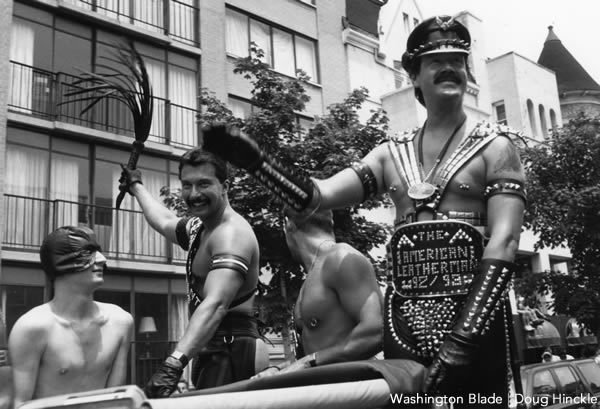
“They were the ones who were brave enough to be themselves and who were raising money for VD clinics before AIDS was even an issue,” she says. “People used to say, ‘But that doesn’t represent me.’ Well guess what — you don’t represent them. We’re a diverse community and this is really about two things — the media’s role and how the media works, which a lot of people don’t understand, and how we within our own community have our own isms — our own internalized homophobia, racism, sexism and transphobia and how it plays out.”
But look at the plaintiffs in the marriage cases and various successful LGBT elected officials, the images they project and it’s not a huge leap to imagine there was some vetting and grooming going on behind the scenes. Sure, those arenas are much different than a Pride event, but even so, one imagines movement gatekeepers would have only been doing their due diligence in monitoring plaintiff or candidate deportment at critical times.
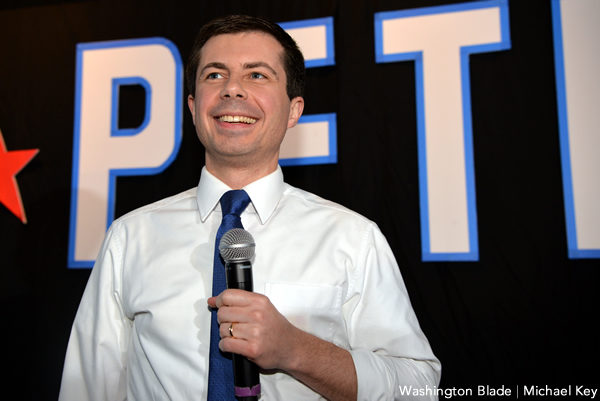
Chuck Wolfe, former president/CEO of the Victory Fund from 2003-2015, says not really.
“I never participated in any conversation like that,” he says. “We had kind of an operating opinion at Victory when I was there that all is fair and it takes every part of our community moving the ball forward and one of the reasons we were successful as fast as we were is because there was no one controlling entity saying, ‘You have to do this,’ or, ‘You can’t do this,’ or, ‘You can’t do that.’ Everybody was doing their part whether it was at a Pride event, testifying on Capitol Hill — all of it mattered, every bit of it.”
Patrick Wojahn, out mayor of College Park, Md., who with his partner Dave Kolesar was one of the couples in the 2006 ACLU/Equality Maryland state marriage case, says it was made clear to him and other plaintiffs to be mindful of their status as representatives.
“One thing we were cognizant of and they made sure we understood was that we were representing the entire LGBT community and we were kind of the face of that,” Wojahn says. “We weren’t supposed to stand in for every single LGBT person out there, but when people saw us, it was understood that how LGBT act, for better or worse, and the political success or failure of what we were doing had a lot to do with how people perceived the LGBT community. It’s true in politics as well. It’s great to have places like Pride where people can act like freaks and do whatever comes upon them to do, but that’s a very different world than say politics where you have to come across as relatable to the people you’re trying to advocate for. It’s best in political situations if you don’t have to overcome that barrier of relatability. If you’re trying to sell people on the idea that we’re entitled to respect, it’s first helpful if they can relate to you on a personal level.”
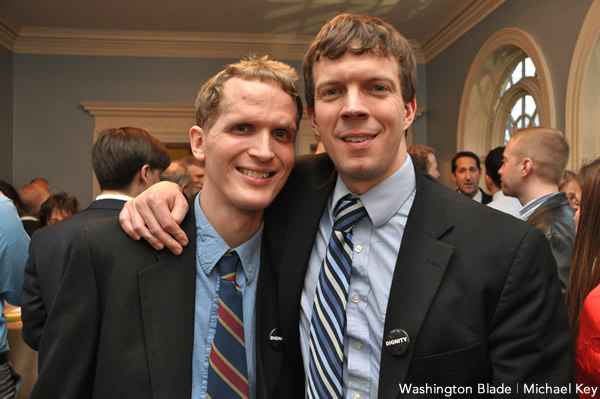
Wojahn says he doubts there was ever much hand-wringing behind the scenes about Pride behavior, but says it’s become less and less of an issue over the years if it ever was one.
“Maybe this is just my skewed perspective of living in the D.C. metro area, but I think there’s been a growing recognition that not all gay people who live next to you are necessarily like the ones out dancing on the floats,” he says. “We’re just as diverse as straight and cisgender people. We have a lot of different things we’re interested in and do a lot of different things. Not all straight people do crazy things. … It’s important to have all different types of people out there being visible.”
Not everyone sees it that way, however. Lloyd Shipley, a longtime 17th Street, N.W. resident, is 70, speaks with a deliciously gravelly voice and prides himself on being a sort of D.C. gay resident curmudgeon type. He’s been attending Capital Pride for 21 years since coming out of straight life (he was married twice to women) and says both Pride and LGBT people in general have gone increasingly downhill over the years.
“This is just my opinion — I believe in opinions and we can have different ones — but I’m so tired of everything being so sexualized in the gay community,” Shipley says. “I feel like Pride has forgotten what Pride is about. You ask nine out of 10 people on Sunday what the theme is this year, they won’t know. But ask them what the best party was, they’ll all know that. I remember my first Pride, I was in Dupont Circle by myself because I didn’t know anybody and I saw float after float and I just cried because they were so meaningful. We should be proud of our accomplishments. Can we knock off the sex shit? Make the floats something to remember. Honor Frank Kameny. Honor Stonewall — not a bunch of guys walking around with their asses hanging out with squirt guns.”
Shipley says it’s not just a Pride problem, but overarching issues he considers rampant among D.C. gays just end up getting writ large there because of the size of the gathering. He says friends in his age bracket are equally fed up.
“I know a lot of older people who say, ‘You know what? I’m done with it. We haven’t been in 15 years.’”
He used to open his home to friends to watch the parade but got tired of ending up with a houseful of 50 people half of whom he says he didn’t know. It took the cake the year he says he found two guys he didn’t know having sex in his bed. This year he’s just inviting a few friends over. They may or may not watch the parade.
“It’s so disorganized,” he says. “It goes on and on, there are huge gaps in the flow, you’ll see float after float after float and none of them reflect the theme whatsoever. It’s gotta mean something. It can’t just be a bunch of half-naked guys throwing beads and squirting people. … I’m gonna write a book someday called ‘Thine Own Worst Enemy.’ We moan and groan about how things are but how much of it is our own damn fault?”
Renna says sensationalizing or using Pride footage as a scare tactic for Middle America may have worked in the short term here and there, but ultimately wasn’t successful.
“I think it did us a favor in that it pushed our visibility,” Renna says. “We pushed through it and it taught us that we need to be better at showing the full diversity of our community. It’s not about don’t show drag queens and leather people, it’s about don’t just show drag queens and leather people.”
Renna says the issue came up constantly in her years of media training. LGBT activists, especially, she says, in smaller markets, lamented the attention the drag queens and go-go boys would get.
“It’s because they’re interesting,” she says. “Be creative, do something interesting. I used to tell GLSEN chapters, rent a school bus, fill it with people, get creative, dress as crossing guards, be fun, be visible. People walking down the street in khakis and T-shirts? Not interesting!”
Wojahn says the whole thing can be touchy.
“If you’re trying to sell people on the idea that we’re entitled to respect, it’s first helpful to relate to them on a personal level,” he says. “You may be taking on a bit more than you can chew when you say, ‘I want you to accept that I’m LGBT, am in a committed relationship and want legal representation with this person, but I also want you to deal with the fact that I’m standing here topless with piercings.”
We asked some early Capital Pride participants for their thoughts.
Ella Fitzgerald, drag queen
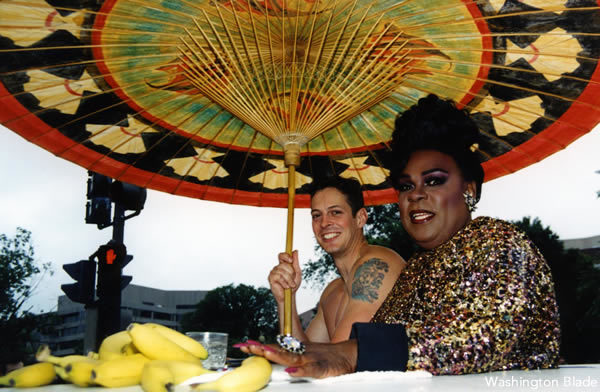
Being a drag queen decade after decade ain’t easy. Just ask Ella Fitzgerald (aka Donnell Robinson), arguably Washington’s most veteran and highly regarded queen.
She remembers her first Capital Pride in 1986 and says it was a much different experience than it is today. Riding with a contingent of Academy of Washington queens in a convertible through Adams Morgan, she remembers being harassed.
“There were straight Latinos giving us the sign language of death signs,” she says. “They harassed the girls on the bikes with their tits out and all that. We’ve definitely come a long way since ’86. It’s much more accepted now. People understand the whole drag thing, the leather community. It’s very diverse now and I remember back in the ‘80s, even in our own community, there was so much discrimination between the drag, the leather and the lesbians. Yes, we still have a long way to go, but we have become much more accommodating of each other’s differences.”
Fitzgerald, 64 and a hairdresser by day, says she was never concerned about being filmed in an early Pride parade or festival. She says she was the first drag queen featured in Washingtonian magazine in 1984 and was happy for the coverage.
She says things have, in her opinion, gotten a bit unnecessarily wild at times over the years.
“The gays who are more flamboyant and make it very obvious, I feel at times that has put a damper on everything we’re trying to achieve,” Fitzgerald says. “How do I say this? There are gays out there on a different level. More class, more sophistication and the younger kids, they’re like wild kids that have been let of a cage and they just act like, ‘I’m gonna do and say whatever I feel at the moment,’ going around in shorts and a T-shirt, ‘cause I want to be seen and I don’t care, this is me and if I want to marry a woman or a man — it’s a lot.”
On the other hand, she doesn’t believe in reining anything in just to be more palatable to straight people.
“Of course not,” she says. “We absolutely need all aspects of the rainbow. I grew up in the ‘70s and it’s amazing to see how far we’ve come in 40-some years. It makes me wonder what the future’s gonna be.”
JOEY DiGUGLIELMO
Margaret McCarthy, Outriders
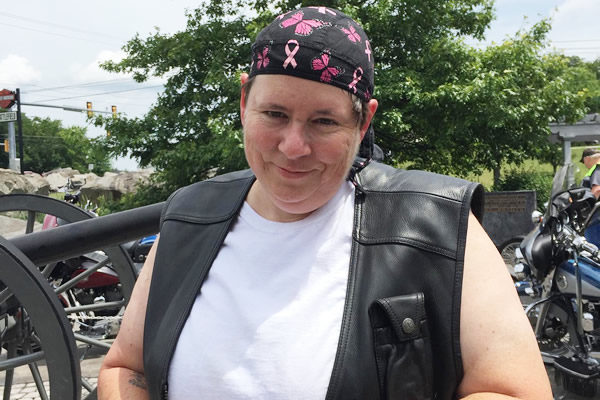
Margaret McCarthy’s Capital Pride experience has evolved over the years.
She came out in the mid-‘80s and has been going to Capital Pride since about ’86 or ’87. She was a member of Open Door Metropolitan Community Church, a sister parish of sorts to MCC-D.C., and participated for years with other parishioners in the Pride parade.
She got into motorcycles around 2009 through a former girlfriend and started riding in Pride with Dykes on Bikes around 2013. A break-off group called Outriders kind of took over a year or so later and eventually McCarthy joined their contingent. They usually have between 40-60 riders each year. Most are members but some join them just for the day.
She agrees with Cathy Renna that a diversity of representation is needed at Pride and in the world in general.
“There are all kinds of people that are part of the gay community — the fairies, the drag queens and all that and that’s part of my community,” says the 54-year-old Montgomery County Police service aide for the 6th District Station in Gaithersburg. “I don’t have to necessarily get it or understand it. I love them and they are part of my community.”
McCarthy says sometimes PDAs get a bit much but it’s not really an LGBT thing.
“I’ve done it. I’ve been walking at Pride and grabbed my girlfriend for a kiss or whatever,” she says. “If you see a couple making out on the Metro or Pride or wherever, I don’t care if they’re gay or straight, I don’t think that’s appropriate. But at a Pride festival, absolutely, it’s about letting go. It’s the one day you can really let your hair down and be totally who you are.”
As for Pride images getting manipulated by political enemies, McCarthy agrees it happens but says LGBT revelers shouldn’t let it dampen their spirits.
“They make it look like it’s all about depravity and sex and stuff and yeah, it makes me mad because that’s not who we are and unfortunately, there are people who may not know gay people and think that’s the whole spectrum. They see that and say, ‘Well look at those faggots and dykes, they’re scum,’ so yeah, it makes me mad. But it’s just one part of our community, it’s not the whole community.”
How has it changed?
McCarthy says she remembers getting harassed at early D.C. Pride events.
“They would see we were with a church and they’d say, ‘How can you be Christian and gay, you’re totally violating the Bible.’ I don’t know if it was Westboro Baptist or who it was, but yeah, there was some of that in the early years.”
McCarthy had protections in writing at her job so she was never worried about being recognized at Pride. She was fully out by her mid-20s.
She says a few Outriders go topless or cover just their nipples.
“I just kind of shake my head and go, ‘Whatever.’ It doesn’t offend me. I don’t really get it — they must get horrible sunburn, but yeah, not many of us do it.”
JOEY DiGUGLIELMO
Kenneth, go-go dancer
Our scantily clad dancer of yore, Kenneth, declined to give his last name. He danced nude at Secrets starting at age 18 from 1996-1999 but is in business now and says he prefers his clients today not know of his past work.
He participated in several Pride parades on the Ziegfeld’s/Secrets float with Ella. The dancers would typically wear matching short shorts and Secrets tank tops.
“I don’t know what the rules are now, I think it’s relaxed a little, but we weren’t ever in thongs or bikinis or things like that,” he says. “We kept it a little more covered back then.”
He was fully out at the time and not fearful of being seen. He says most of the dancers then who were gay were out and not fearful of being seen. A few dancers were straight, he says, but “didn’t seem concerned about” being in a Pride parade.
Now 40, he remembers those years fondly.
“It was a very interesting thing to do when I was 19 or 20. I got to sew my wild oats and it was good experience overall. I learned a lot.”
Kenneth says it’s probably a non-issue today but he suspects more scandalous Pride behavior probably did work against LGBT rights in years past.
“There was a lack of exposure then so if all you saw through the ‘70s to the ‘90s was how they televised it, then you only knew part of the story. I think once there was more exposure, people understood that was only one aspect of the community.”
He says Pride was a much different experience for everyone 20-30 years ago.
“For a lot of people, that was the only time they could be gay,” he says. “They weren’t able to dress and behave the way they wanted to the other 364 days of the year, it was back to their normal attire and behavior, so I would say it’s died down some because we can be ourselves more year round now. If you could only do that during Pride, people tended to go more over the top.”
JOEY DiGUGLIELMO
John Watson, leather enthusiast
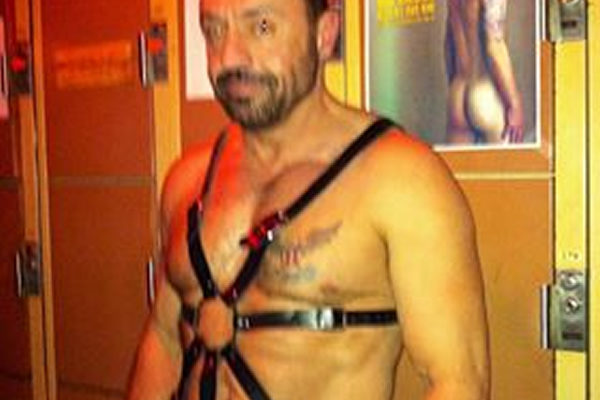
Gay leather enthusiast John Watson says he first got into the D.C. leather scene at age 16 when he and two male friends his age, who lived in Arlington, began going to the D.C. Eagle, the city’s only leather bar, around 1974.
It was a time when the city’s bars and nightclubs, both gay and straight, didn’t consistently require ID checks for young-looking customers, Watson says.
About one year later, in June 1975, shortly after he turned 17, Watson and his two gay friends attended D.C.’s first Gay Pride event, which consisted of a block party on 20th Street, N.W., near Dupont Circle.
Although the three were getting more and more into the leather scene and drove into D.C. nearly every weekend to go to the Eagle, neither of them wore leather at that first Pride block party, Watson says.
“We had on shorts and tank tops, which of course we took off and were shirtless,” he says. “But with the leather scene back then, people didn’t want to appear out in public in it. And thinking back, I don’t remember seeing anybody that first time in leather. There may have been, but I don’t remember seeing anybody in leather.”
It wasn’t until around 1980, Watson thinks, when the D.C. Pride festival had moved from 20th Street to the grounds of Francis School next to P Street Beach Park, that leather enthusiasts began attending Pride wearing leather clothes and gear.
“As it progressed more and more you saw more leather,” he says. “It was when people got to the point where they really weren’t scared, more or less around 1980. People got tired of being in the closet.”
Watson recalls that in the earlier years he and his friends, along with many others in the leather scene, were fearful of the possible repercussions of being publicly identified as leather guys. Being so identified would automatically out you as being gay, he says, as well as out you — even among gays — as being weird or odd.
“It was what you would call an underground community,” he says. “A lot of people felt it was not only strange but perverted, to be honest. If you were into that, you kept your mouth shut most of the time because you didn’t want anyone to know. Even the regular gay people were, ‘Oh, wow, that’s perverted.’ It wasn’t until the 1990s that I began to wear leather in public. Before that I would take it with me and put it on inside the clubs.”
Thankfully, Watson said, attitudes began to change as the LGBT rights movement became more visible and assertive in the 1980s and 1990s. He recalls seeing far more leather folks at D.C. Pride events in those years, possibly even more than what is seen in more recent years as the Pride events have become more “corporatized.”
Watson, who works in insurance, says he managed to keep his interest in leather separate from his work other than times he has worked at the Eagle. Among his most interesting “day work” jobs, he said was a stint from 1983-1988 as an assistant clerk at the U.S. Supreme Court.
Among other things, he gave private tours at the court to gay rights pioneer Frank Kameny and then-Washington Blade News Editor Lisa Keen.
LOU CHIBBARO, Jr.
a&e features
Doug Spearman takes his chance
‘Noah’s Arc: The Movie’ debuted on Paramount+ last month
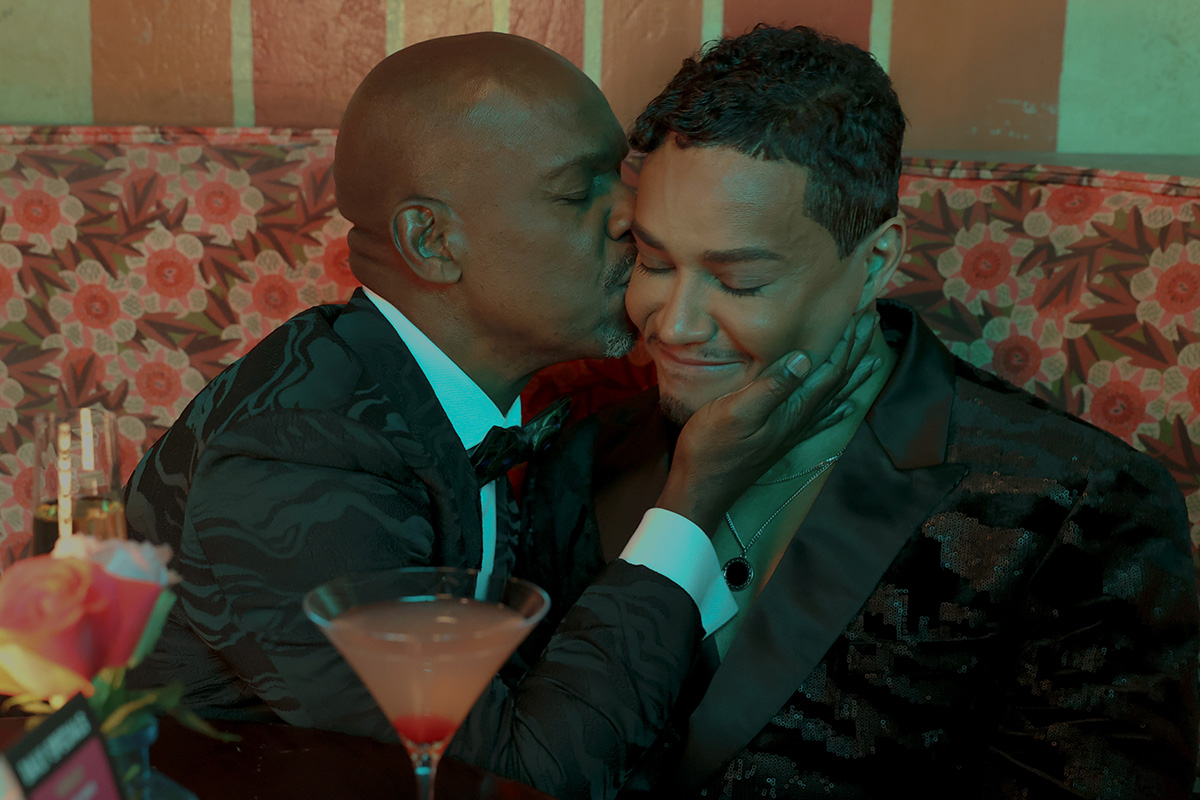
There’s no question that when Patrik-Ian Polk’s series “Noah’s Arc” premiered on Logo 20 years ago, it was a groundbreaking creation. The story of a group of Black gay men and their wonderful friendship. The titular arc was that of the cute main character, Noah (Darryl Stephens), and his close-knit circle of friends, including Chance played by gay actor Doug Spearman. This compelling and loving fraternity may, in fact, be what brought viewers back repeatedly, including a 2008 movie, “Noah’s Arc: Jumping the Broom,” as well as the 2020 “Noah’s Arc” short, and now, a new full-length feature “Noah’s Arc: The Movie,” debuting on Paramount+ on June 20. In the movie, filled with equal measures of laughs and tears, Chance, who has faced a devastating loss, finds his dependable friends there, ready to support and comfort him at a moment’s notice. I had the pleasure of speaking with Spearman the morning of the streaming premiere of “Noah’s Arc: The Movie.”
WASHINGTON BLADE: Doug, since the early 2000s, when the “Noah’s Arc” series premiered on Logo, you have been playing the character of Chance, including in the latest installment, “Noah’s Arc: The Movie.” What was it about Chance that appealed to you as an actor?
SPEARMAN: When Patrik (-Ian Polk) called me to ask me to play him (Chance), I was at JFK airport in the baggage claim, waiting for a suitcase. He explained what the part was. The thing that stuck out to me was the fact that Chance was in a long-term relationship with another Black man. And, they had a child; they had a 4-year-old daughter named Kenya. I had never seen two Black gay men raise a child on TV before. I thought it was the most revolutionary thing I’d ever seen. I immediately thought I’ve got to do this because that was something nobody had seen. I thought it was incredibly important to take the part.
BLADE: “Noah’s Arc: The Movie” was, once again, written and directed by Patrik-Ian Polk, who you just mentioned, is the creator of the entire franchise. What’s the secret to your long-standing working relationship?
SPEARMAN: [Laughs] the whole team, all of us, are like a band of brothers. We fight like brothers, we come together like brothers, we hash things out, we talk, because we’re all very different from our characters. I think the challenge of playing these guys and then uplifting these men, playing a part, especially something written by Patrik, is like solving a math equation. There’s always a challenge that’s enjoyable for me as an actor: to try to find out what it is that Patrik wants, and then how do I do it.
BLADE: I think you do a very good job of it.
SPEARMAN: Thank you very much
BLADE: In the years between “Jumping the Broom” and the new full-length movie, many changes have occurred, and the story addresses some of them, including gay widowhood, which is something that the aging community is now confronting, as well as mental health issues. Please say a few words about how you approached those subjects in the new movie.
SPEARMAN: I had a lot of loss in my life, right before we started shooting. Two months before we started shooting the first series, my mother died. I was going through the grief process through that whole first season. Since then, I’ve lost a lot of people in my life. In fact, when we started shooting the second season, the second week we were shooting, my ex died of a heart attack. I was having to fold that into what I was doing with my life on the set and off the set. You’ve got to show up and you’ve got to do your work. The first two seasons of “Noah’s Arc” are always tinged with the memory of grief. So, when I had to deal with the death that Chance faces (in the new movie), which is a significant death in his life, it wasn’t that hard to reach back, especially the scene in the graveyard. It was something that I unfortunately could pull from personal experience.
BLADE: Shifting gears, the movie features delightful cast surprises, including Jasmine Guy and TS Madison. Did you have a chance to interact with either or both when they were on set?
SPEARMAN: No, I didn’t have any scenes with Jasmine, and I missed her. I wish I had gotten to see her because I actually got to direct Jasmine for a CBS promo shoot for “Queen,” back in the early ‘90s. I had a huge crush on her when she was on “A Different World.” So, I really would have liked to reconnect. But TS and I got to see each other every day because I was in all her scenes. It was extraordinary being around somebody like that. That is one outspoken woman!
BLADE: Even though Beyoncé never makes an appearance in the movie, there’s a lot of talk about her. Would you say you are a Beyoncé fan?
SPEARMAN: Yes! I’m breathing! Yes, I’m a Beyoncé fan. I actually got the chance to meet her. I knew her mom. Her mom was extraordinary to me. She is in the second movie I directed. She also gave us a wedding gown to use in the very first scene of the movie. That family is extraordinarily important to me. Not only just to be a fan, but to be somebody who’s gotten to know them and work with them and see how hard they work. I don’t think anybody works as hard as Tina or Beyoncé.
BLADE: There was a recent news item about gay actor Benito Skinner of the Amazon Prime series “Overcompensating” being told not to bother auditioning for straight roles. As an out actor yourself, how important do you think it is for queer characters to be portrayed by queer actors, and vice versa?
SPEARMAN: Being queer is a multifaceted identity. There’s no one kind of queer person. I think finding the best actor that’s your first circle of casting. I think one of the joys about being an actor is that you get to play different parts. I play straight guys all the time. Dads and husbands and things like that. I think a lot of people are told not to do it. In fact, I wouldn’t be Chance if the actor who was originally cast as Chance hadn’t been pulled out of the series by his agents because they didn’t want him to play a gay character.
BLADE: That’s amazing! Thank you for sharing that. Without giving away too much, the ending of the movie is a little ambiguous, even ending with a question mark. If there was a “Noah’s Arc: The Movie” sequel, would you come back for that?
SPEARMAN: Yeah! A lot of it would depend on what Chance’s journey is going to be like. Patrik and I have conversations like that all the time. He’s very interested and supportive of input. I hope I would be, as we all would be, part of the creative growth with these characters. They live in Patrik’s head, and he writes them, but we’re the ones who have to flesh them out. It’s a conversation, it’s always a conversation.
BLADE: You are currently performing in Molière’s “The Imaginary Invalid” as part of the New Orleans Shakespeare Festival at Tulane. What has this experience been like for you?
SPEARMAN: It’s extraordinary! I started on stage when I was seven. There’s nothing like working with a live audience and having that immediacy. I’m working with an extraordinarily talented cast in a really great play, and I have some of the best scene partners I could ever want.
BLADE: Are there any upcoming film or TV projects you’d like to mention?
SPEARMAN: I’m still a writer, and I’m still a director, and I’ve still got scripts that I would like to make. I have a little something that’s a cross between “Treme” and “Bridgerton” that I want to do. I’m always trying to figure out what the next thing is.
a&e features
Visit Cambridge, a ‘beautiful secret’ on Maryland’s Eastern Shore
New organization promotes town’s welcoming vibe, LGBTQ inclusion
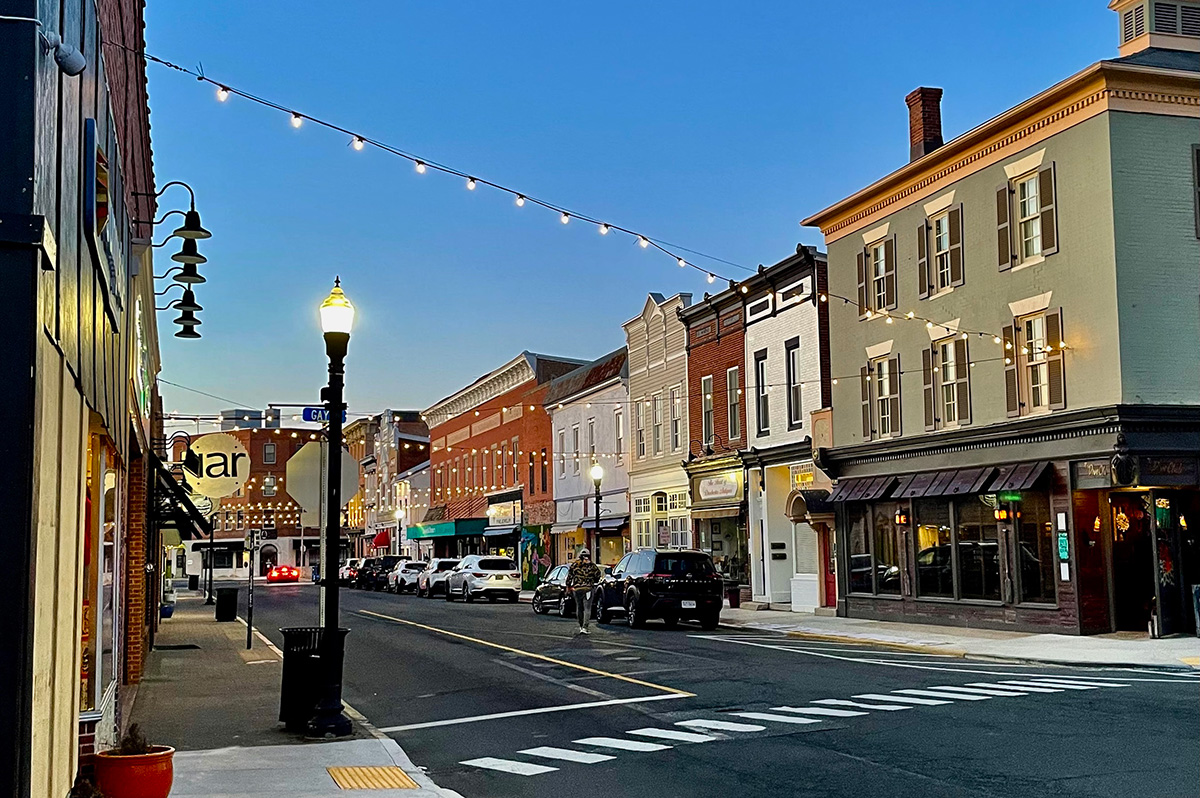
CAMBRIDGE, Md. — Driving through this scenic, historic town on Maryland’s Eastern Shore, you’ll be charmed by streets lined with unique shops, restaurants, and beautifully restored Victorian homes. You’ll also be struck by the number of LGBTQ Pride flags flying throughout the town.
The flags are a reassuring signal that everyone is welcome here, despite the town’s location in ruby red Dorchester County, which voted for Donald Trump over Kamala Harris by a lopsided margin. But don’t let that deter you from visiting. A new organization, Proudly Cambridge, is holding its debut Pride event this weekend, touting the town’s welcoming, inclusive culture.
“We stumbled on a beautiful secret and we wanted to help get the word out,” said James Lumalcuri of the effort to create Proudly Cambridge.
The organization celebrates diversity, enhances public spaces, and seeks to uplift all that Cambridge has to share, according to its mission statement, under the tagline “You Belong Here.”
The group has so far held informal movie nights and a picnic and garden party; the launch party is June 28 at the Cambridge Yacht Club, which will feature a Pride celebration and tea dance. The event’s 75 tickets sold out quickly and proceeds benefit DoCo Pride.
“Tickets went faster than we imagined and we’re bummed we can’t welcome everyone who wanted to come,” Lumalcuri said, adding that organizers plan to make “Cheers on the Choptank” an annual event with added capacity next year.
One of the group’s first projects was to distribute free Pride flags to anyone who requested one and the result is a visually striking display of a large number of flags flying all over town. Up next: Proudly Cambridge plans to roll out a program offering affirming businesses rainbow crab stickers to show their inclusiveness and LGBTQ support. The group also wants to engage with potential visitors and homebuyers.
“We want to spread the word outside of Cambridge — in D.C. and Baltimore — who don’t know about Cambridge,” Lumalcuri said. “We want them to come and know we are a safe haven. You can exist here and feel comfortable and supported by neighbors in a way that we didn’t anticipate when we moved here.”

Lumalcuri, 53, a federal government employee, and his husband, Lou Cardenas, 62, a Realtor, purchased a Victorian house in Cambridge in 2021 and embarked on an extensive renovation. The couple also owns a home in Adams Morgan in D.C.
“We saw the opportunity here and wanted to share it with others,” Cardenas said. “There’s lots of housing inventory in the $300-400,000 range … we’re not here to gentrify people out of town because a lot of these homes are just empty and need to be fixed up and we’re happy to be a part of that.”
Lumalcuri was talking with friends one Sunday last year at the gazebo (affectionately known as the “gayzebo” by locals) at the Yacht Club and the idea for Proudly Cambridge was born. The founding board members are Lumalcuri, Corey van Vlymen, Brian Orjuela, Lauren Mross, and Caleb Holland. The group is currently working toward forming a 501(c)3.
“We need visibility and support for those who need it,” Mross said. “We started making lists of what we wanted to do and the five of us ran with it. We started meeting weekly and solidified what we wanted to do.”
Mross, 50, a brand strategist and web designer, moved to Cambridge from Atlanta with her wife three years ago. They knew they wanted to be near the water and farther north and began researching their options when they discovered Cambridge.
“I had not heard of Cambridge but the location seemed perfect,” she said. “I pointed on a map and said this is where we’re going to move.”
The couple packed up, bought a camper trailer and parked it in different campsites but kept coming back to Cambridge.
“I didn’t know how right it was until we moved here,” she said. “It’s the most welcoming place … there’s an energy vortex here – how did so many cool, progressive people end up in one place?”
Corey van Vlymen and his husband live in D.C. and were looking for a second home. They considered Lost River, W.Va., but decided they preferred to be on the water.
“We looked at a map on both sides of the bay and came to Cambridge on a Saturday and bought a house that day,” said van Vlymen, 39, a senior scientist at Booz Allen Hamilton. They’ve owned in Cambridge for two years.
They were drawn to Cambridge due to its location on the water, the affordable housing inventory, and its proximity to D.C.; it’s about an hour and 20 minutes away.
Now, through the work of Proudly Cambridge, they hope to highlight the town’s many attributes to residents and visitors alike.
“Something we all agree on is there’s a perception problem for Cambridge and a lack of awareness,” van Vlymen said. “If you tell someone you’re going to Cambridge, chances are they think, ‘England or Massachusetts?’”
He cited the affordability and the opportunity to save older, historic homes as a big draw for buyers.
“It’s all about celebrating all the things that make Cambridge great,” Mross added. “Our monthly social events are joyful and celebratory.” A recent game night drew about 70 people.
She noted that the goal is not to gentrify the town and push longtime residents out, but to uplift all the people who are already there while welcoming new visitors and future residents.
They also noted that Proudly Cambridge does not seek to supplant existing Pride-focused organizations. Dorchester County Pride organizes countywide Pride events and Delmarva Pride was held in nearby Easton two weeks ago.
“We celebrate all diversity but are gay powered and gay led,” Mross noted.
To learn more about Proudly Cambridge, visit the group on Facebook and Instagram.
What to see and do
Cambridge, located 13 miles up the Choptank River from the Chesapeake Bay, has a population of roughly 15,000. It was settled in 1684 and named for the English university town in 1686. It is home to the Harriet Tubman Museum, mural, and monument. Its proximity to the Blackwater National Wildlife Refuge makes it a popular stop for birders, drawn to more than 27,000 acres of marshland dubbed “the Everglades of the north.”
The refuge is walkable, bikeable, and driveable, making it an accessible attraction for all. There are kayaking and biking tours through Blackwater Adventures (blackwateradventuresmd.com).
Back in town, take a stroll along the water and through historic downtown and admire the architecture. Take in the striking Harriet Tubman mural (424 Race St.). Shop in the many local boutiques, and don’t miss the gay-owned Shorelife Home and Gifts (421 Race St.), filled with stylish coastal décor items.
Stop for breakfast or lunch at Black Water Bakery (429 Race St.), which offers a full compliment of coffee drinks along with a build-your-own mimosa bar and a full menu of creative cocktails.
The Cambridge Yacht Club (1 Mill St.) is always bustling but you need to be a member to get in. Snapper’s on the water is temporarily closed for renovations. RaR Brewing (rarbrewing.com) is popular for craft beers served in an 80-year-old former pool hall and bowling alley. The menu offers burgers, wings, and other bar fare.
For dinner or wine, don’t miss the fantastic Vintage 414 (414 Race St.), which offers lunch, dinner, wine tasting events, specialty foods, and a large selection of wines. The homemade cheddar crackers, inventive flatbreads, and creative desserts (citrus olive oil cake, carrot cake trifle) were a hit on a recent visit.
Also nearby is Ava’s (305 High St.), a regional chain offering outstanding Italian dishes, pizzas, and more.
For something off the beaten path, visit Emily’s Produce (22143 Church Creek Rd.) for its nursery, produce, and prepared meals.
“Ten minutes into the sticks there’s a place called Emily’s Produce, where you can pay $5 and walk through a field and pick sunflowers, blueberries, you can feed the goats … and they have great food,” van Vlymen said.
As for accommodations, there’s the Hyatt Regency Chesapeake Bay (100 Heron Blvd. at Route 50), a resort complex with golf course, spa, and marina. Otherwise, check out Airbnb and VRBO for short-term rentals closer to downtown.
Its proximity to D.C. and Baltimore makes Cambridge an ideal weekend getaway. The large LGBTQ population is welcoming and they are happy to talk up their town and show you around.
“There’s a closeness among the neighbors that I wasn’t feeling in D.C.,” Lumalcuri said. “We look after each other.”
a&e features
James Baldwin bio shows how much of his life is revealed in his work
‘A Love Story’ is first major book on acclaimed author’s life in 30 years
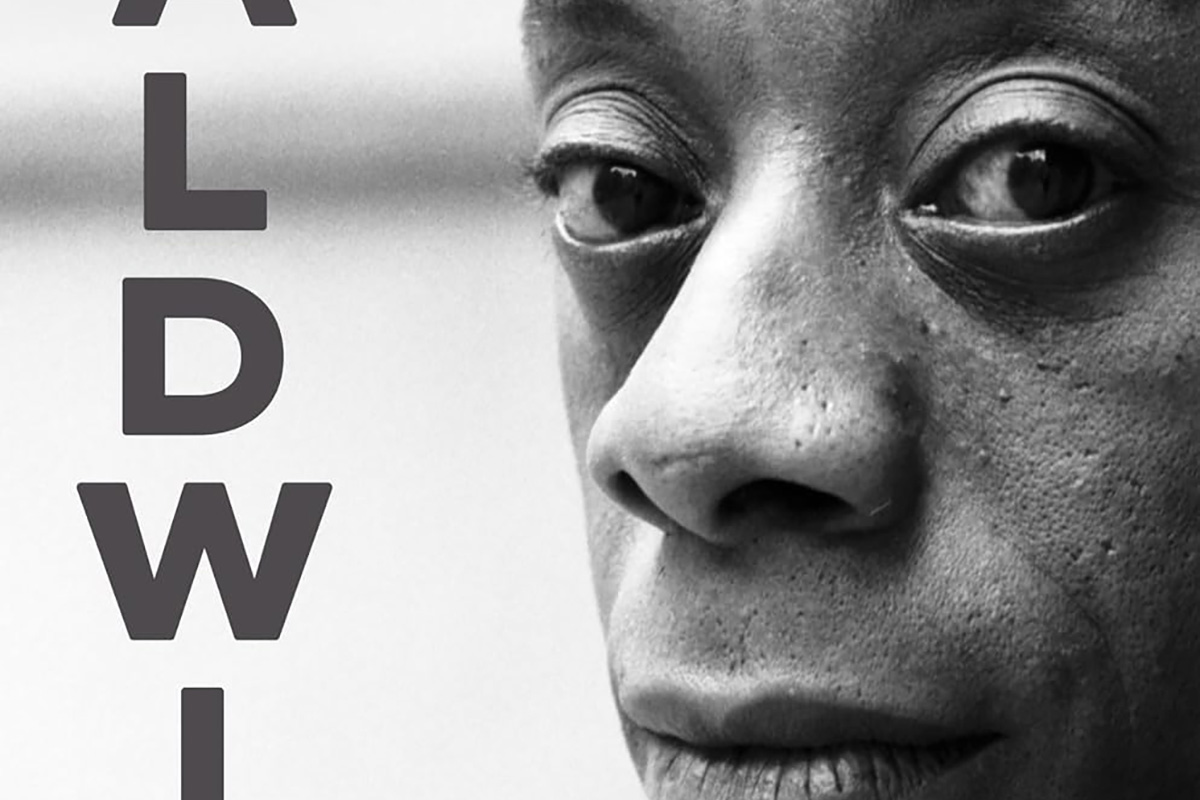
‘Baldwin: A Love Story’
By Nicholas Boggs
c.2025, FSG
$35/704 pages
“Baldwin: A Love Story” is a sympathetic biography, the first major one in 30 years, of acclaimed Black gay writer James Baldwin. Drawing on Baldwin’s fiction, essays, and letters, Nicolas Boggs, a white writer who rediscovered and co-edited a new edition of a long-lost Baldwin book, explores Baldwin’s life and work through focusing on his lovers, mentors, and inspirations.
The book begins with a quick look at Baldwin’s childhood in Harlem, and his difficult relationship with his religious, angry stepfather. Baldwin’s experience with Orilla Miller, a white teacher who encouraged the boy’s writing and took him to plays and movies, even against his father’s wishes, helped shape his life and tempered his feelings toward white people. When Baldwin later joined a church and became a child preacher, though, he felt conflicted between academic success and religious demands, even denouncing Miller at one point. In a fascinating late essay, Baldwin also described his teenage sexual relationship with a mobster, who showed him off in public.
Baldwin’s romantic life was complicated, as he preferred men who were not outwardly gay. Indeed, many would marry women and have children while also involved with Baldwin. Still, they would often remain friends and enabled Baldwin’s work. Lucien Happersberger, who met Baldwin while both were living in Paris, sent him to a Swiss village, where he wrote his first novel, “Go Tell It on the Mountain,” as well as an essay, “Stranger in the Village,” about the oddness of being the first Black person many villagers had ever seen. Baldwin met Turkish actor Engin Cezzar in New York at the Actors’ Studio; Baldwin later spent time in Istanbul with Cezzar and his wife, finishing “Another Country” and directing a controversial play about Turkish prisoners that depicted sexuality and gender.
Baldwin collaborated with French artist Yoran Cazac on a children’s book, which later vanished. Boggs writes of his excitement about coming across this book while a student at Yale and how he later interviewed Cazac and his wife while also republishing the book. Baldwin also had many tumultuous sexual relationships with young men whom he tried to mentor and shape, most of which led to drama and despair.
The book carefully examines Baldwin’s development as a writer. “Go Tell It on the Mountain” draws heavily on his early life, giving subtle signs of the main character John’s sexuality, while “Giovanni’s Room” bravely and openly shows a homosexual relationship, highly controversial at the time. “If Beale Street Could Talk” features a woman as its main character and narrator, the first time Baldwin wrote fully through a woman’s perspective. His essays feel deeply personal, even if they do not reveal everything; Lucian is the unnamed visiting friend in one who the police briefly detained along with Baldwin. He found New York too distracting to write, spending his time there with friends and family or on business. He was close friends with modernist painter Beauford Delaney, also gay, who helped Baldwin see that a Black man could thrive as an artist. Delaney would later move to France, staying near Baldwin’s home.
An epilogue has Boggs writing about encountering Baldwin’s work as one of the few white students in a majority-Black school. It helpfully reminds us that Baldwin connects to all who feel different, no matter their race, sexuality, gender, or class. A well-written, easy-flowing biography, with many excerpts from Baldwin’s writing, it shows how much of his life is revealed in his work. Let’s hope it encourages reading the work, either again or for the first time.





